Paper Orchid Stationery is reader-supported. When you buy through links on our site, we may earn an affiliate commission. Learn more.
Are you looking for a unique and elegant way to make a lasting impression? Look no further than letterpress cards. In this guide, we’ll dive into the world of letterpress printing, its history, advantages and disadvantages, and the types of cards you can create. Plus, we’ll explore the design process and compare letterpress printing to digital printing.

What is Letterpress?
Letterpress printing is a technique where ink is pressed into paper using a raised surface. The process involves creating a custom plate or block with the desired design, which is then inked and pressed onto the paper with a printing press. The result is a textured, three-dimensional print that stands out from the page.
History of Letterpress
The origins of letterpress printing date back to ancient China, where ink was pressed onto paper using carved wooden blocks. The technique later spread to Europe, where movable type was invented in the 15th century. Letterpress printing became the standard for mass printing until the rise of offset printing in the 20th century. Today, letterpress printing is considered a timeless and artisanal printing method.
Advantages and Disadvantages of Letterpress
Advantages
- High-quality, tactile prints that stand out
- Customizable designs and colors
- Durable and long-lasting prints
- Creates a sense of luxury and elegance
Disadvantages
- Higher cost compared to digital printing
- Longer production time
- Limited color options
- Not ideal for large quantities
Types of Letterpress Cards
Wedding Invitations
Letterpress wedding invitations are a popular choice for couples who want to create a memorable and elegant invitation suite. Customizable designs and colors allow couples to create a unique and personalized invitation that sets the tone for their big day.
Business Cards
Letterpress business cards are a great way to make a lasting impression with potential clients or partners. The tactile quality of letterpress printing conveys a sense of quality and luxury, making your business stand out from the competition.
Greeting Cards
Letterpress greeting cards are perfect for special occasions such as birthdays, holidays, or anniversaries. Customizable designs and colors allow you to create a unique and personalized card that stands out from generic store-bought options.
Stationery
Letterpress stationery is a great way to elevate your personal or professional correspondence. Customizable designs and colors allow you to create a unique and personalized letterhead, note card, or envelope that showcases your style.
How to Design Letterpress Cards
Choosing the Right Paper
When designing letterpress cards, it’s important to choose the right paper. Thick, high-quality paper with a smooth finish works best for letterpress printing. The paper should be able to withstand the pressure of the printing press and show off the texture of the ink.
Selecting the Right Font and Typography
Letterpress printing works best with bold, simple fonts and typography. Avoid thin or intricate fonts that may not translate well to the printing press. Consider adding texture or embossing to your design to enhance the tactile quality of the print.
Choosing the Right Ink
Letterpress ink comes in a variety of colors, including metallic and fluorescent options. Consider the overall design and style of your card when selecting ink colors. Remember that letterpress printing produces a textured, layered print that may affect the final color and appearance of the ink.
Letterpress vs Digital Printing
While letterpress printing offers a unique and high-quality printing method, it does come with some limitations. Digital printing, on the other hand, offers more flexibility and affordability. Here are some key differences between the two methods:
Letterpress Printing
- High-quality, tactile prints
- Customizable designs and colors
- Limited color options
- Higher cost and longer production time
Digital Printing
- Fast production time
- Unlimited color options
- Affordable for large quantities
- Less tactile than letterpress printing
Conclusion
Letterpress cards offer a unique and elegant way to make a lasting impression. Whether you’re creating wedding invitations, business cards, greeting cards, or stationery, letterpress printing allows you to create a high-quality and personalized print that stands out from the competition. With the right design and careful selection of paper and ink, letterpress printing can elevate any occasion or correspondence to a new level of luxury.
FAQ
What is the difference between letterpress and embossing?
Letterpress printing involves pressing ink into paper using a raised surface, while embossing involves creating a raised design on the paper without ink. Both techniques create a tactile, three-dimensional print.
Can I print photographs using letterpress?
While letterpress printing is not ideal for printing photographs, it is possible to incorporate photographic elements into a letterpress design. Consider using a design that incorporates line drawings or a limited color palette to achieve the best results.
What is the production time for letterpress cards?
Production time for letterpress cards varies depending on the complexity of the design and the quantity ordered. Generally, it takes 2-4 weeks for production and shipping.
Amazon and the Amazon logo are trademarks of Amazon.com, Inc, or its affiliates.